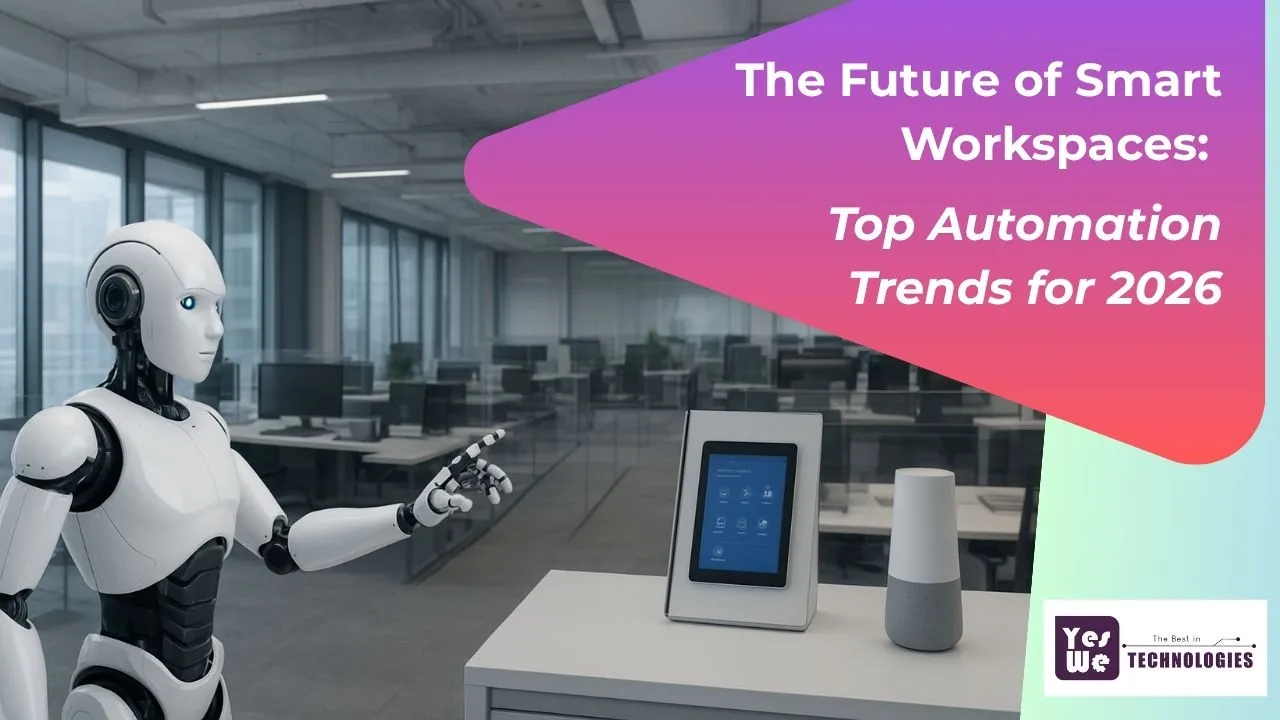Introduction
The workplace is changing faster than ever before. From traditional cubicles to cloud-based collaboration and IoT-enabled offices, the way we work has been constantly evolving. But as we step into 2026, one thing is clear — automation is no longer just a trend, it’s the backbone of smart workspaces.
Companies across the globe, especially in tech-driven hubs like Bangalore, are investing in office automation and smart office solutions to boost productivity, improve sustainability, and enhance workplace security. So, what does the future hold for smart workspaces in 2026? Let’s explore.
The Evolution of Smart Workspaces
Smart workspaces have come a long way. What began as simple digital tools to improve communication has now transformed into AI-driven, sensor-based, and automation-powered ecosystems.
- In the early 2000s, digitalization meant email and intranets.
- The 2010s brought cloud tools, mobile work, and flexible office designs.
- Post-2020, we saw hybrid work models, IoT-enabled offices, and AI-powered productivity platforms.
Now, in 2026, smart workspaces are becoming intelligent ecosystems that not only make businesses efficient but also sustainable, secure, and employee-friendly.
Key Automation Trends to Expect in 2026
1. AI-Powered Workflows & Digital Assistants
AI is no longer just about chatbots. In 2026, smart offices use AI copilots to automate workflows, manage data, and assist employees in daily decision-making.
- AI tools will schedule meetings, draft emails, and manage reports.
- Machine learning will help predict workloads and optimize resource allocation.
- Virtual AI assistants will become a part of daily operations, reducing repetitive tasks and freeing employees to focus on innovation.
2. IoT-Enabled Office Infrastructure
IoT has turned office infrastructure into a living, responsive ecosystem.
- Smart HVAC systems regulate climate based on occupancy and weather.
- IoT sensors track energy use, ensuring lights and devices switch off when not in use.
- Predictive maintenance reduces downtime by alerting teams before equipment fails.
This isn’t just about convenience — it’s about saving costs and making offices more sustainable.
Also read 👉 How IoT-Based Smart Office Automation Improves Productivity and Security?
3. Hybrid Work & Smart Collaboration Tools
The hybrid work model is here to stay, and in 2026, automation makes it seamless.
- AR/VR-powered meeting rooms create immersive collaboration experiences.
- Smart scheduling systems let employees book desks and meeting rooms instantly.
- Cloud-based automation ensures smooth collaboration between in-office and remote teams.
Hybrid offices are no longer chaotic — they’re efficient, flexible, and employee-first.
4. Sustainable Smart Workspaces
Sustainability is at the heart of automation in 2026. Offices are integrating green automation solutions:
- Smart lighting systems cut down on unnecessary electricity consumption.
- AI-driven HVAC ensures optimal energy usage.
- IoT-powered data analytics help companies achieve green certifications with measurable metrics.
Businesses in Bangalore, a city already focused on sustainability, are rapidly embracing eco-friendly smart office automation solutions.
5. Advanced Office Security Solutions
Corporate security has expanded far beyond CCTV. In 2026, AI-powered access control and surveillance systems are standard.
- Biometric-based smart access (facial recognition, fingerprints) ensures authorized entry.
- IoT-integrated fire detection systems improve workplace safety.
- Cybersecurity automation prevents unauthorized data breaches in real-time.
Security is no longer just physical — it’s digital, automated, and proactive.
Additional read 👉 How to Choose the Right CCTV Camera for Your Home or Business
6. Smart Furniture & Ergonomics
Offices are not just smart — they’re healthy workspaces.
- AI-driven desks adjust height and remind employees to take breaks.
- Ergonomic chairs track posture and suggest corrections.
- Smart pods allow employees to work in distraction-free spaces within open offices.
This shift highlights that employee well-being is as important as efficiency in 2026.
7. Region-Specific Insights: Smart Workspaces in Bangalore & India
Bangalore, India’s Silicon Valley, is a frontrunner in adopting smart office solutions.
- Startups and enterprises alike are investing in corporate automation for efficiency.
- Local offices are integrating networking solutions, IoT devices, and AI-based tools.
- Demand for office automation in Bangalore is rapidly growing, fueled by the city’s hybrid workforce and energy-conscious ecosystem.
Challenges in Smart Workspace Automation
Of course, challenges exist:
- Cybersecurity risks with connected devices.
- High implementation costs for small businesses.
- Employee adaptability – training teams to use AI and IoT tools effectively.
However, companies that invest early will reap long-term benefits in productivity, savings, and competitive advantage.
Preparing for the Future – How Businesses Can Transition
If your business wants to future-proof its office, here’s the way forward:
- Start small with smart lighting and climate control systems.
- Gradually integrate AI-powered collaboration and scheduling tools.
- Work with a trusted office automation provider who can guide the transition.
This is where Yes We Technologies steps in — with expertise in corporate automation and smart office solutions in Bangalore, they help businesses make the switch to future-ready workplaces.
Conclusion
The future of smart workspaces in 2026 is about creating offices that think, respond, and adapt. With AI, IoT, sustainability, and advanced security, businesses can unlock higher productivity, happier employees, and stronger security.
Ready to transform your office into a future-ready smart workspace? Partner with Yes We Technologies, the leading provider of office automation solutions in Bangalore. From smart access control to energy-efficient IoT systems, we design workspaces that are intelligent, secure, and sustainable.
👉 Contact Yes We Technologies today and take the first step toward a smarter, safer, and more productive office environment.


